This document provides an outline and overview of topics related to arrays and matrices. It begins with an introduction to one-dimensional arrays, how they are represented in memory, and common operations on arrays. It then discusses the limitations of linear arrays and introduces multidimensional arrays. Specific types of multidimensional arrays covered include two-dimensional arrays and special matrices such as diagonal, tridiagonal, lower triangular, and upper triangular matrices. Memory mapping techniques for multidimensional arrays like row-major and column-major ordering are also summarized.
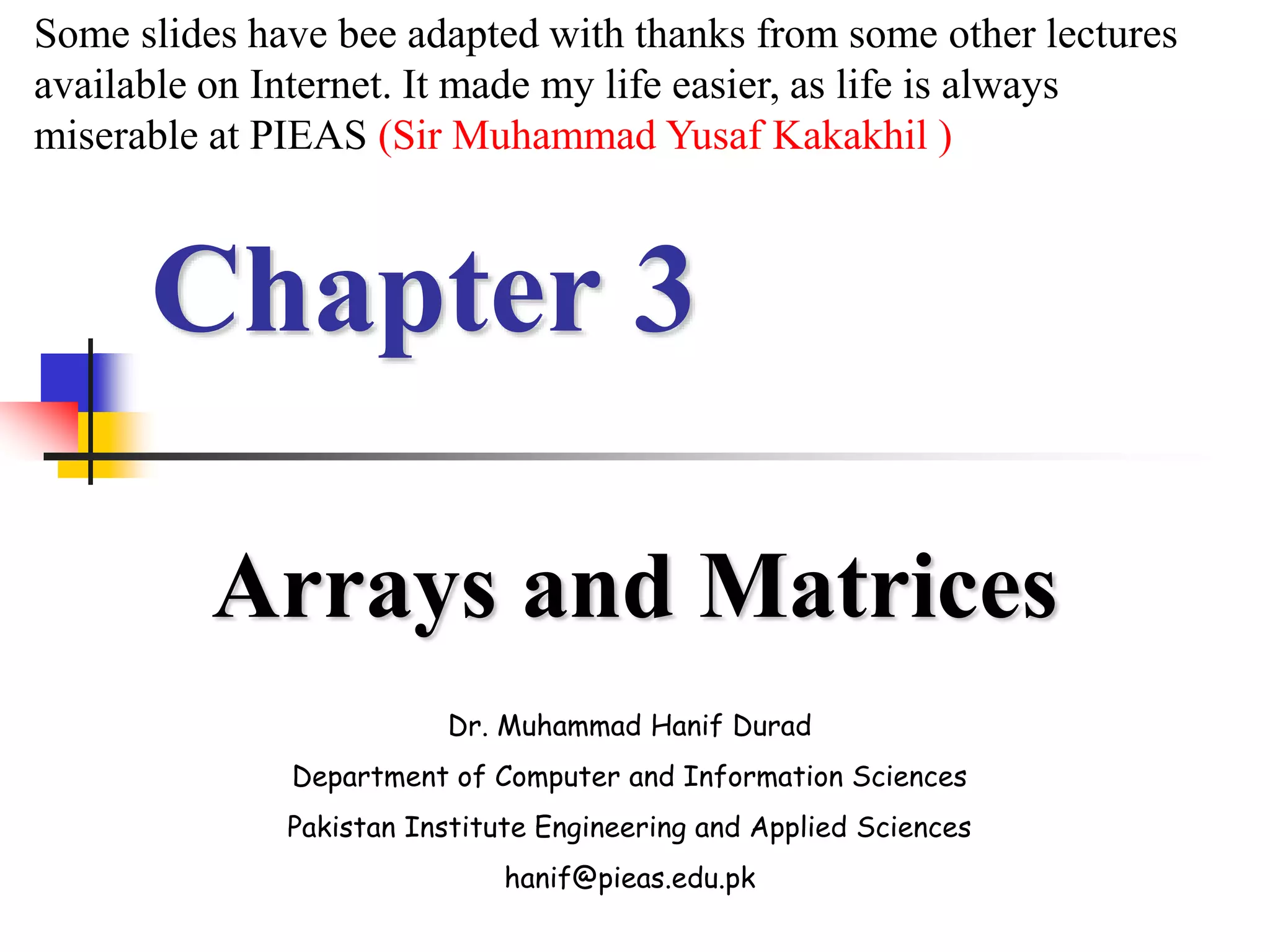
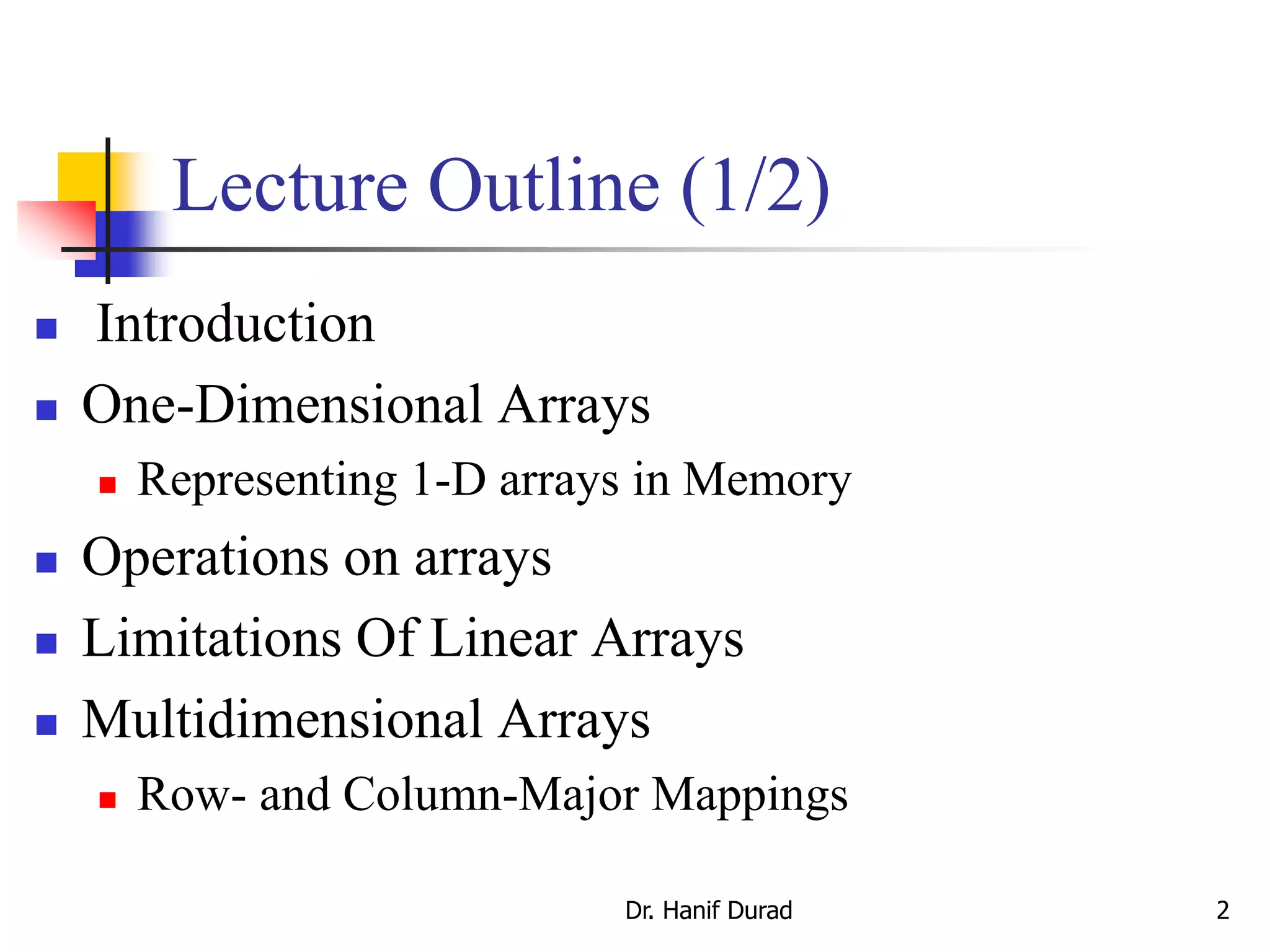

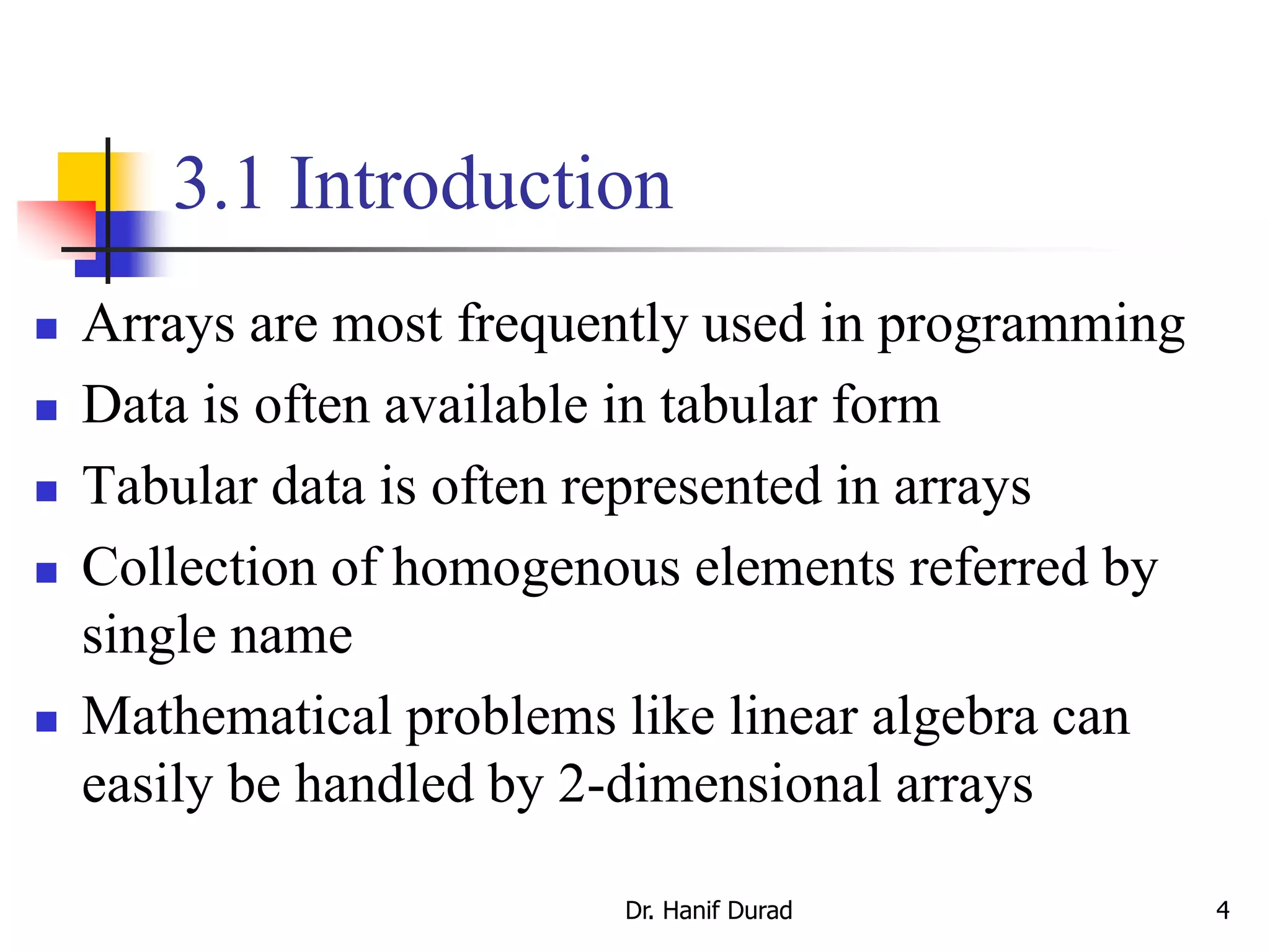
![5
3.3 One-Dimensional Arrays (1/2)
Suppose, you need to store years of 100 cars.
Will you define 100 variables?
int y1, y2,…, y100;
An array is an indexed data structure to represent
several variables having the same data type: int
y[100];
y[0] y[1] y[2] … y[k-1] y[k] y[k+1] … y[98] y[99]
D:Data StructuresHanif_SearchArrays and Matrices Chap5.ppt](https://image.slidesharecdn.com/chapter3ds-190904110927/75/Chapter-3-ds-5-2048.jpg)
![6
One-Dimensional Arrays (2/2)
An element of an array is accessed using the
array name and an index or subscript, for
example: y[5] which can be used like a variable
In C, the subscripts always start with 0 and
increment by 1, so y[5] is the sixth element
The name of the array is the address of the first
element and the subscript is the offset
y[0] y[1] y[2] … y[k-1] y[k] y[k+1] … y[98] y[99]](https://image.slidesharecdn.com/chapter3ds-190904110927/75/Chapter-3-ds-6-2048.jpg)
![7
3.2 Definition and Initialization
An array is defined using a declaration
statement.
data_type array_name[size];
allocates memory for size elements
subscript of first element is 0
subscript of last element is size-1
size must be a constant](https://image.slidesharecdn.com/chapter3ds-190904110927/75/Chapter-3-ds-7-2048.jpg)
![8
Example
int list[5];
allocates memory for 5 integer variables
subscript of first element is 0
subscript of last element is 4
C does not check bounds on arrays
list[6] =5; /* may give segmentation fault or
overwrite other memory locations*/
list[0]
list[1]
list[2]
list[3]
list[4]](https://image.slidesharecdn.com/chapter3ds-190904110927/75/Chapter-3-ds-8-2048.jpg)
![9
Initializing Arrays
Arrays can be initialized at the time they are
declared.
Examples:
double taxrate[3] ={0.15, 0.25, 0.3};
char list[5] = {‘h’, ’e’, ’l’, ’l’, ’o’};
double vector[100] = {0.0}; /* assigns
zero to all 100 elements */
int s[] = {5,0,-5}; /*the size of s is 3*/](https://image.slidesharecdn.com/chapter3ds-190904110927/75/Chapter-3-ds-9-2048.jpg)
![10
Assigning values to an array
For loops are often used to assign values to an array
Example:
int list[5], i;
for(i=0; i<5; i++){
list[i] = i;
} list[0]
list[3]
list[4]
list[1]
list[2]
0
1
2
3
4
list[0]
list[1]
list[2]
list[3]
list[4]
OR
for(i=0; i<=4; i++){
list[i] = i;
}](https://image.slidesharecdn.com/chapter3ds-190904110927/75/Chapter-3-ds-10-2048.jpg)
![11
Assigning values to an array
Give a for loop to assign the below values to list
int list[5], i;
for(i=0; i<5; i++){
list[i] = 4-i;
}
list[0]
list[3]
list[4]
list[1]
list[2]
4
3
2
1
0](https://image.slidesharecdn.com/chapter3ds-190904110927/75/Chapter-3-ds-11-2048.jpg)
![3.4 Representing 1-D arrays in
Memory (1/2)
Dr. Hanif Durad 12
1-dimensional array x = [a, b, c, d]
map into contiguous memory locations
Memory
a b c d
start
• location(x[i]) = start + i
D:Data StructuresCSED232lecture3-array.ppt](https://image.slidesharecdn.com/chapter3ds-190904110927/75/Chapter-3-ds-12-2048.jpg)


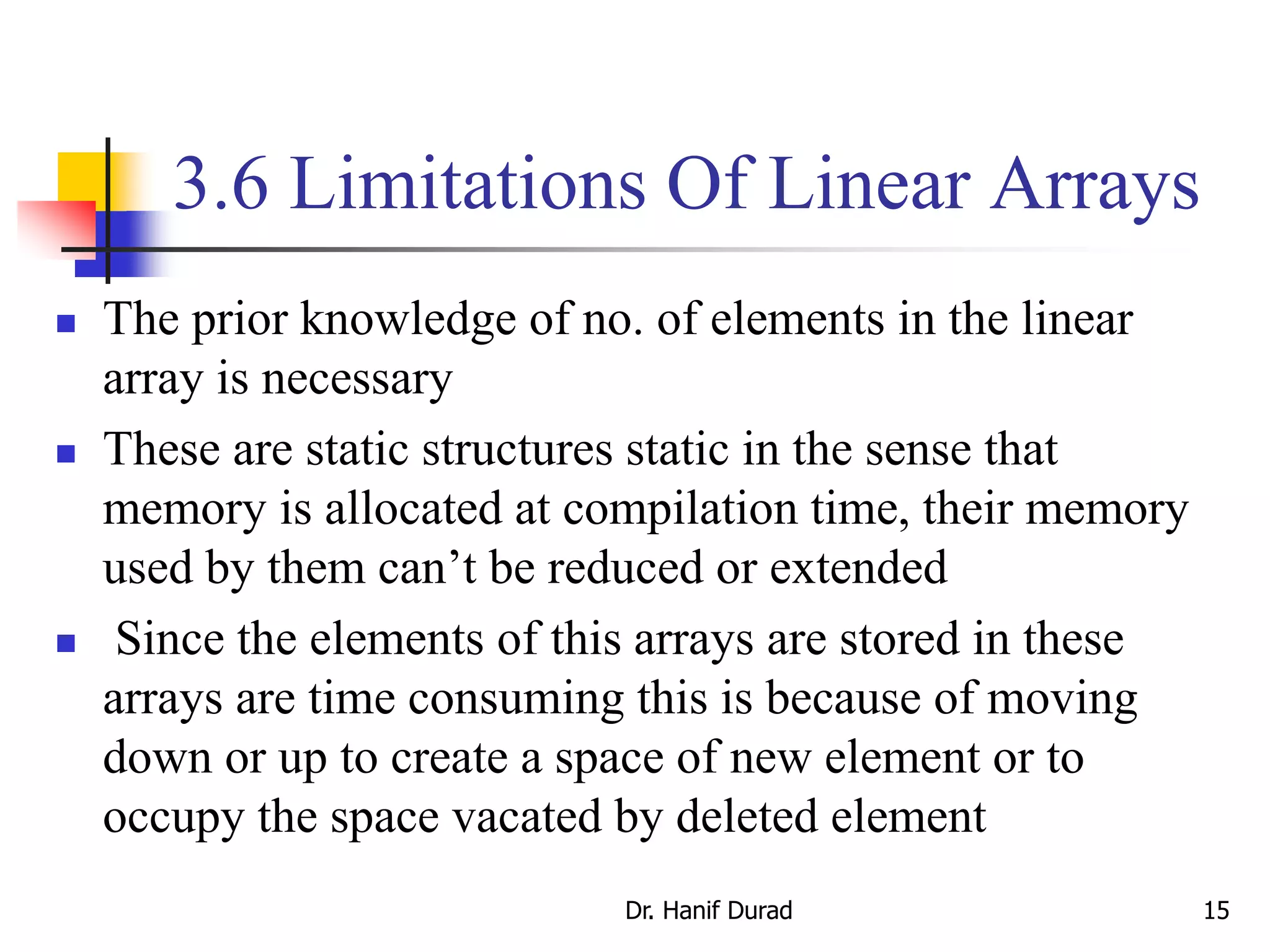
![3.7 Multidimensional Arrays
An array can have many dimensions – if it has more than
one dimension, it is called a multidimensional array
Each dimension subdivides the previous one into the
specified number of elements
Each dimension has its own length
Memory requirement changes drastically, can result in
shortage of memory
e.g.
int X [3] [4] [5];
Dr. Hanif Durad 16
D:Data StructuresHanif_SearchArrays and Matrices20080714_MultiD.ppt+
D:Data StructuresHanif_SearchArrays and MatricesMultidimensional Arrays.ppt](https://image.slidesharecdn.com/chapter3ds-190904110927/75/Chapter-3-ds-16-2048.jpg)
![3.8 2-D Arrays
The elements of a 2-dimensional array a
declared as:
int a[3][4];
may be shown as a table
a[0][0] a[0][1] a[0][2] a[0][3]
a[1][0] a[1][1] a[1][2] a[1][3]
a[2][0] a[2][1] a[2][2] a[2][3]
Dr. Hanif Durad 17
D:Data StructuresCSED232lecture4-arrays.ppt](https://image.slidesharecdn.com/chapter3ds-190904110927/75/Chapter-3-ds-17-2048.jpg)
![Rows of a 2D Array
Dr. Hanif Durad 18
a[0][0] a[0][1] a[0][2] a[0][3] row 0
a[1][0] a[1][1] a[1][2] a[1][3] row 1
a[2][0] a[2][1] a[2][2] a[2][3] row 2](https://image.slidesharecdn.com/chapter3ds-190904110927/75/Chapter-3-ds-18-2048.jpg)
![Columns of a 2D Array
Dr. Hanif Durad 19
a[0][0] a[0][1] a[0][2] a[0][3]
a[1][0] a[1][1] a[1][2] a[1][3]
a[2][0] a[2][1] a[2][2] a[2][3]
column 0 column 1 column 2 column 3](https://image.slidesharecdn.com/chapter3ds-190904110927/75/Chapter-3-ds-19-2048.jpg)
![2D Array Representation in C++
view 2D array as a 1D array of rows
x = [row0, row1, row 2]
row 0 = [a, b, c, d]
row 1 = [e, f, g, h]
row 2 = [i, j, k, l]
and store as 4 1D arrays
2-dimensional array x
a, b, c, d
e, f, g, h
i, j, k, l](https://image.slidesharecdn.com/chapter3ds-190904110927/75/Chapter-3-ds-20-2048.jpg)
![2D Array Representation in C++
a b c d
e f g h
i j k l
x[]
4 separate
1-dimensional arrays
space overhead = overhead for 4 1D arrays
= 4 * 4 bytes
= 16 bytes
= (number of rows + 1) x 4 bytes](https://image.slidesharecdn.com/chapter3ds-190904110927/75/Chapter-3-ds-21-2048.jpg)
![Array Representation in C++
This representation is called the array-of-arrays representation.
Requires contiguous memory of size 3, 4, 4, and 4 for the 4 1D
arrays.
1 memory block of size number of rows and number of rows
blocks of size number of columns
a b c d
e f g h
i j k l
x[]](https://image.slidesharecdn.com/chapter3ds-190904110927/75/Chapter-3-ds-22-2048.jpg)
![Row-Major Mapping
Example 3 x 4 array:
a b c d
e f g h
i j k l
Convert into 1D array y by collecting elements by rows.
Within a row elements are collected from left to right.
Rows are collected from top to bottom.
We get y[] = {a, b, c, d, e, f, g, h, i, j, k, l}
row 0 row 1 row 2 … row i
3.9 Representing 2-D arrays in Memory](https://image.slidesharecdn.com/chapter3ds-190904110927/75/Chapter-3-ds-23-2048.jpg)
![Locating Element x[i][j]
assume x has r rows and c columns
each row has c elements
i rows to the left of row i
so ic elements to the left of x[i][0]
x[i][j] is mapped to position
ic + j of the 1D array
row 0 row 1 row 2 … row i
0 c 2c 3c ic
3.10 Address Calculation for 2-D Array](https://image.slidesharecdn.com/chapter3ds-190904110927/75/Chapter-3-ds-24-2048.jpg)

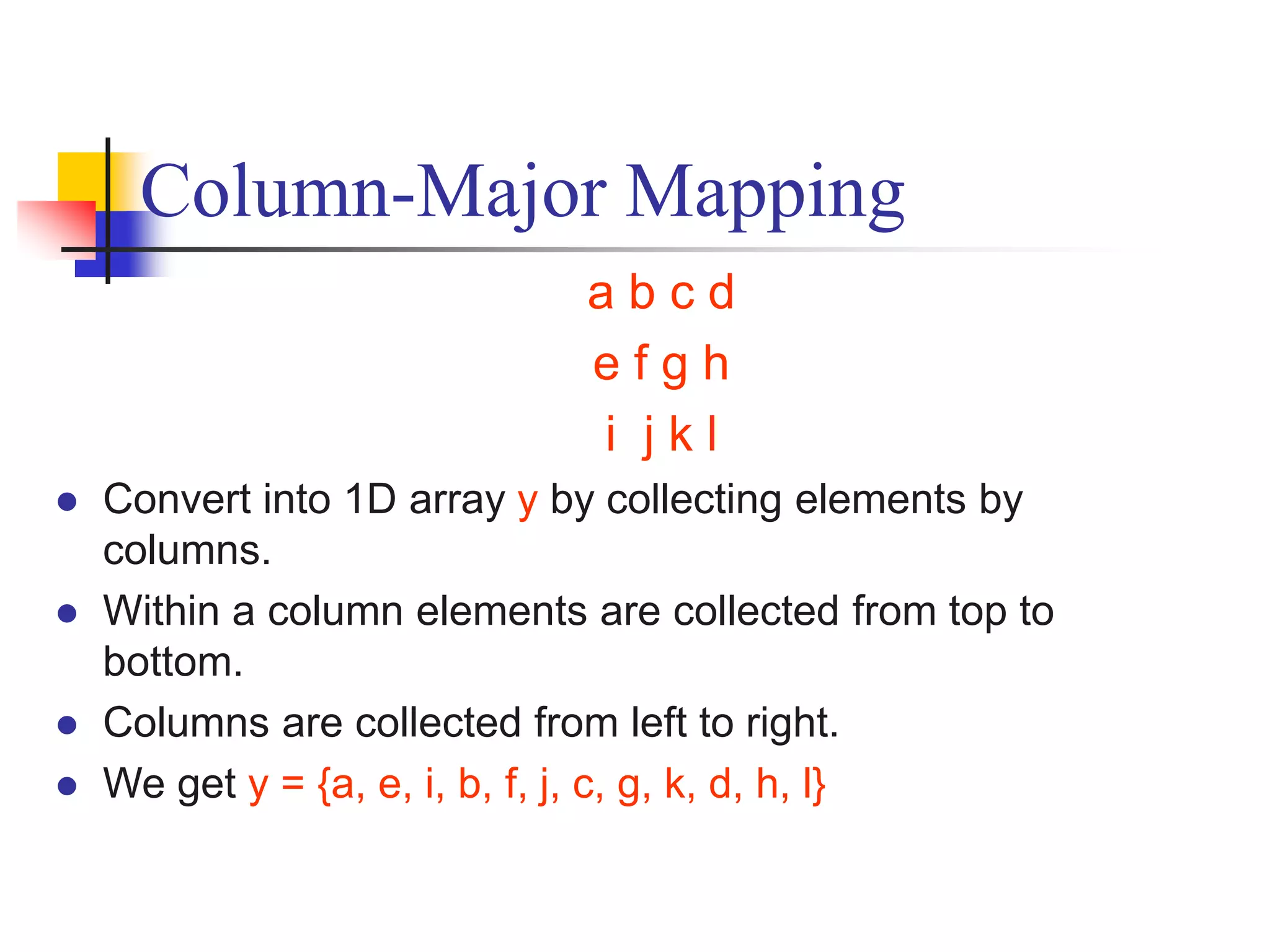
![27
Row- and Column-Major
Mappings
2D Array int a[3][6];
a[0][0] a[0][1] a[0][2] a[0][3] a[0][4] a[0][5]
a[1][0] a[1][1] a[1][2] a[1][3] a[1][4] a[1][5]
a[2][0] a[2][1] a[2][2] a[2][3] a[2][4] a[2][5]](https://image.slidesharecdn.com/chapter3ds-190904110927/75/Chapter-3-ds-27-2048.jpg)

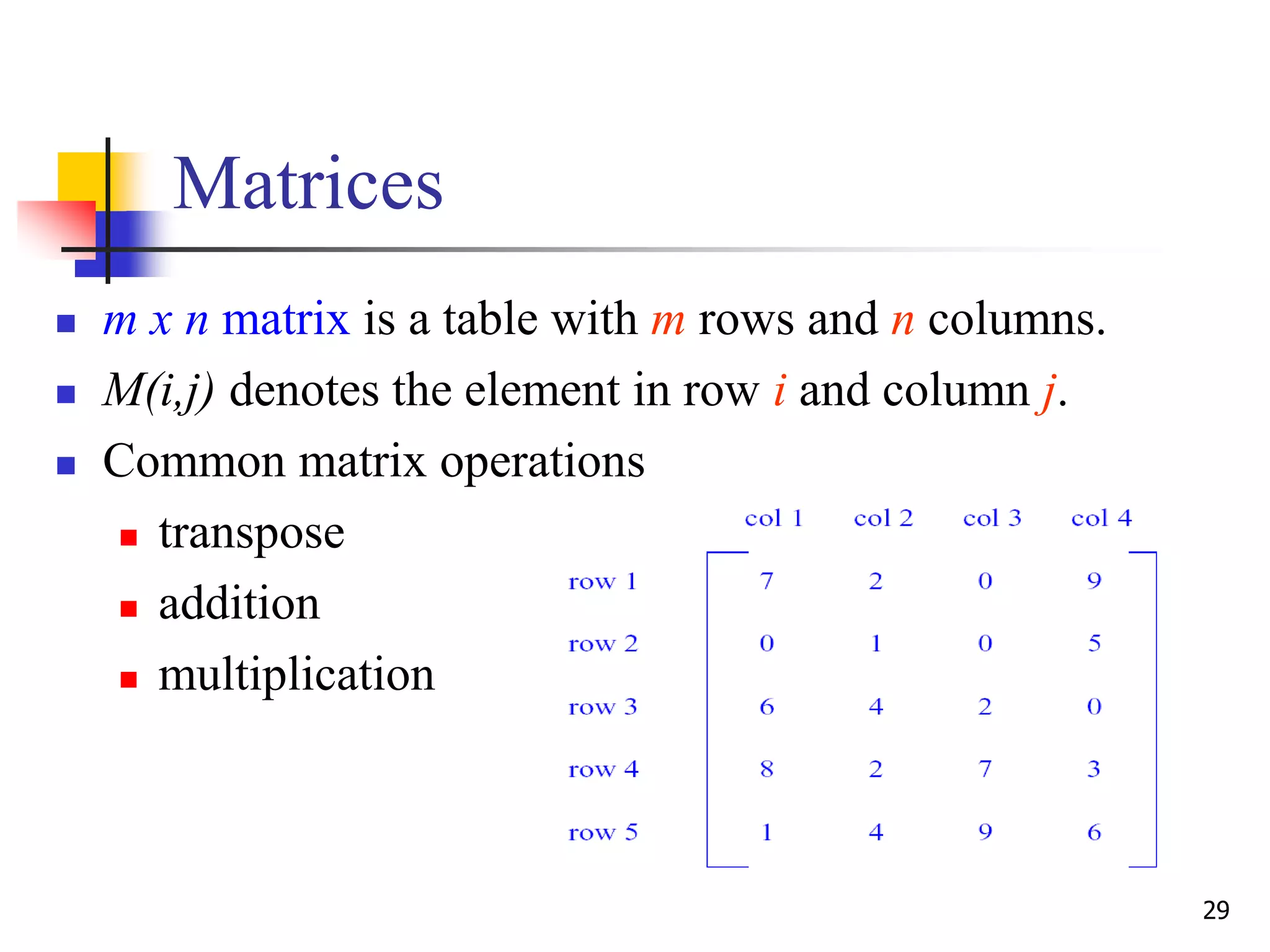
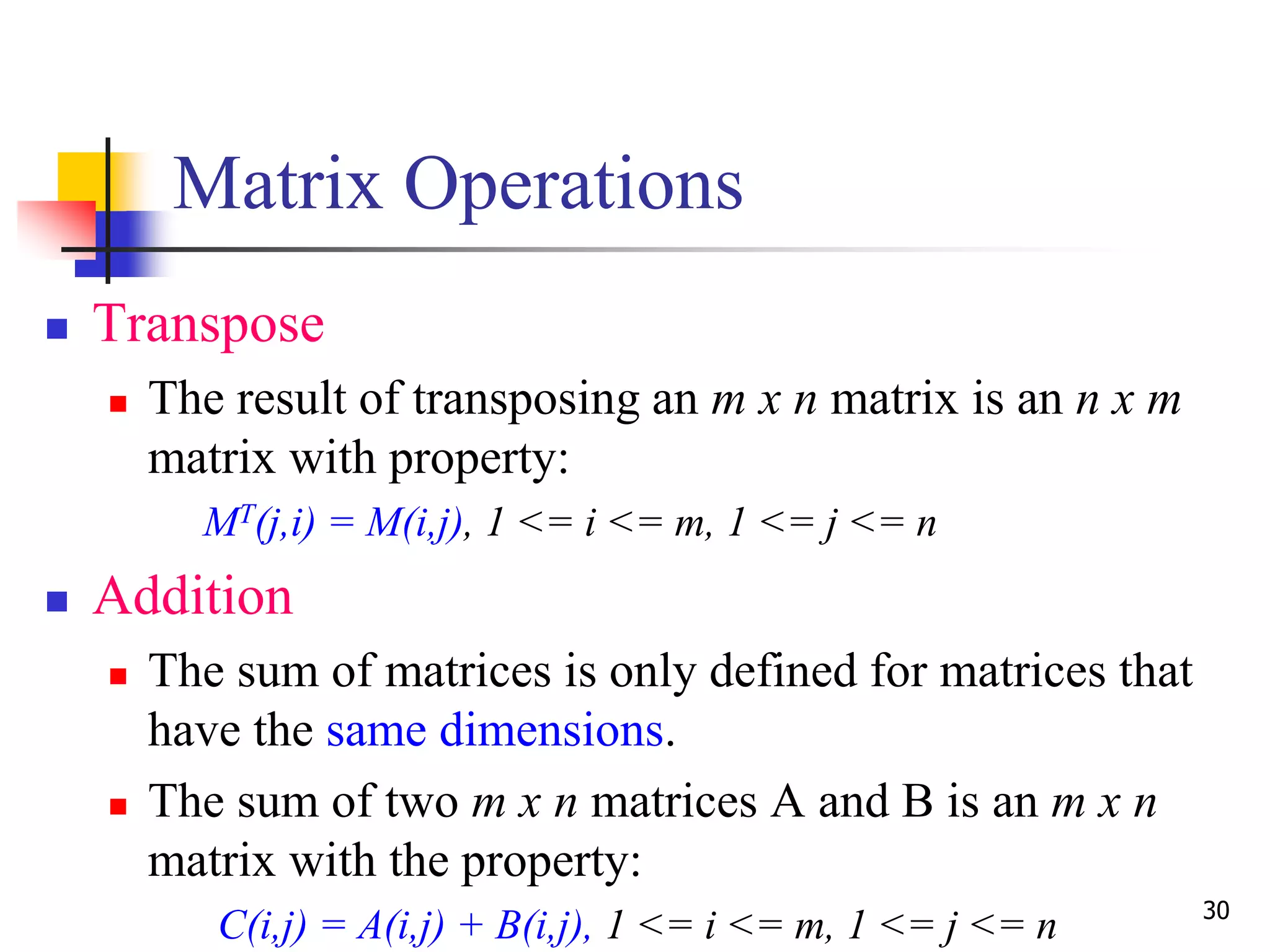
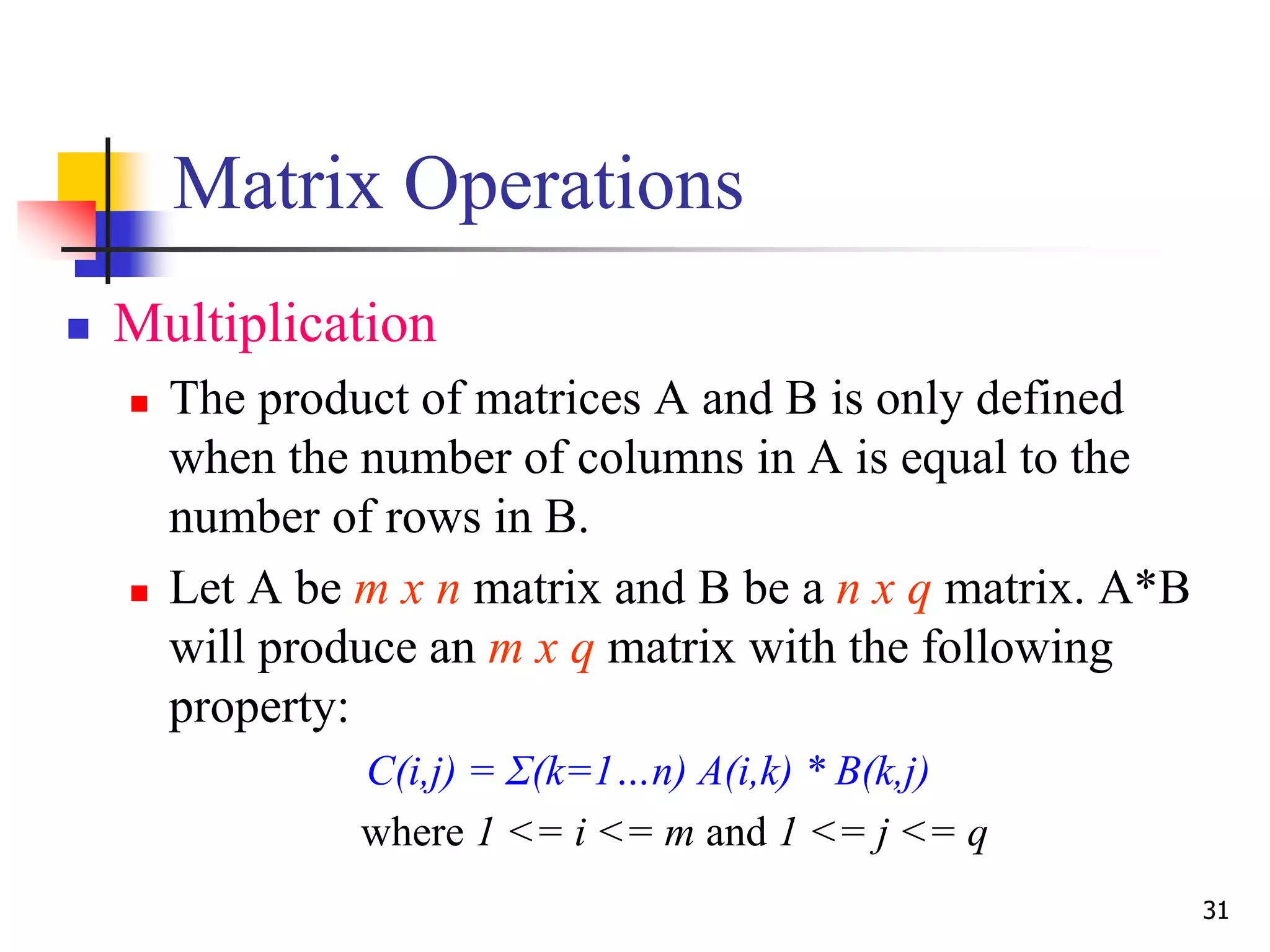


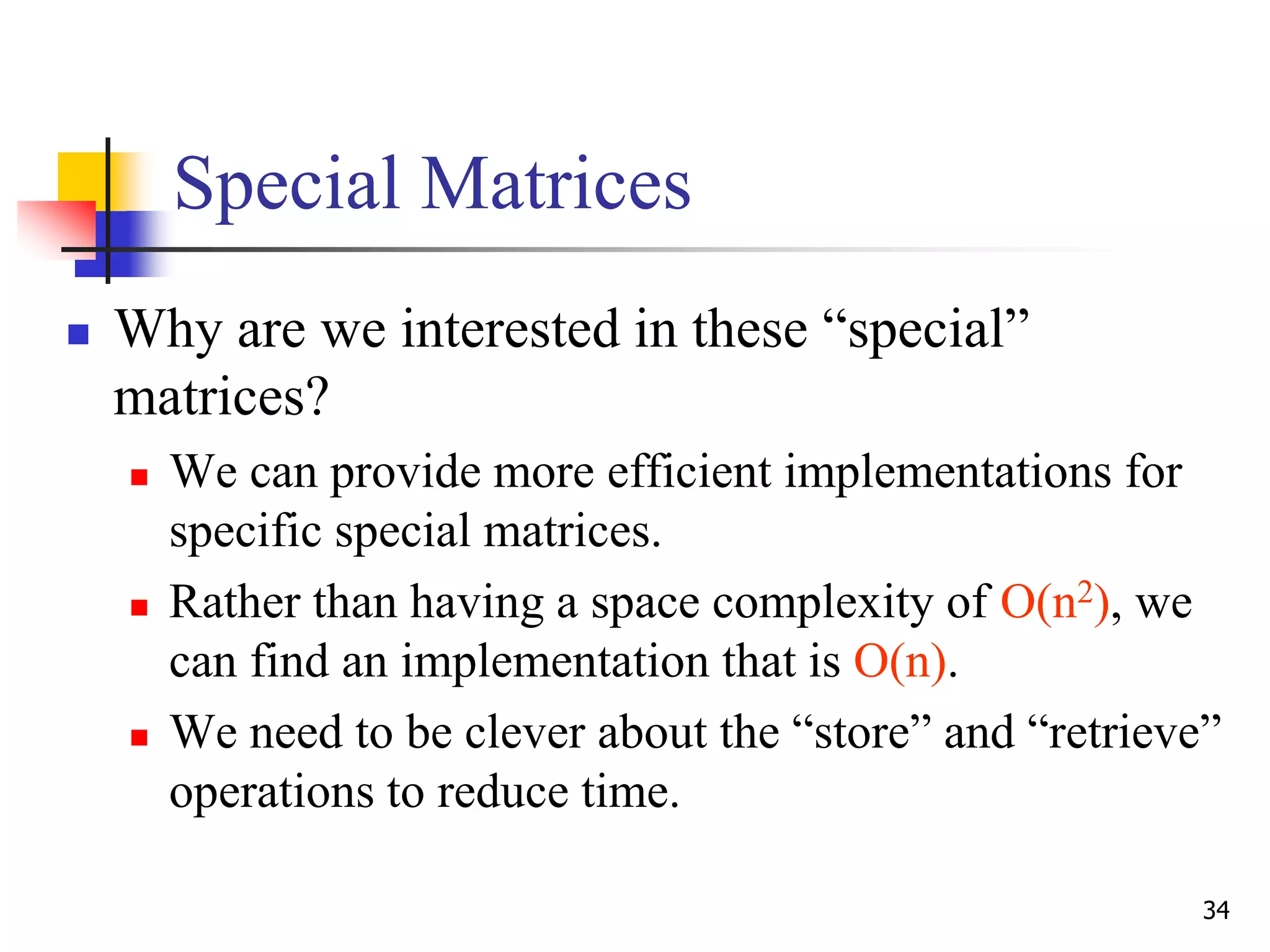
![35
Diagonal Matrix
Naive way to represent n x n diagonal matrix
requires n2 x sizeof (T) bytes of memory where T is
the data type of elements
Better way
a[i-1]= 0 for D(i,j) where i = j
0 for D(i,j) where i ≠ j
requires n x sizeof(T) bytes of memory
DS-1, P-95](https://image.slidesharecdn.com/chapter3ds-190904110927/75/Chapter-3-ds-35-2048.jpg)
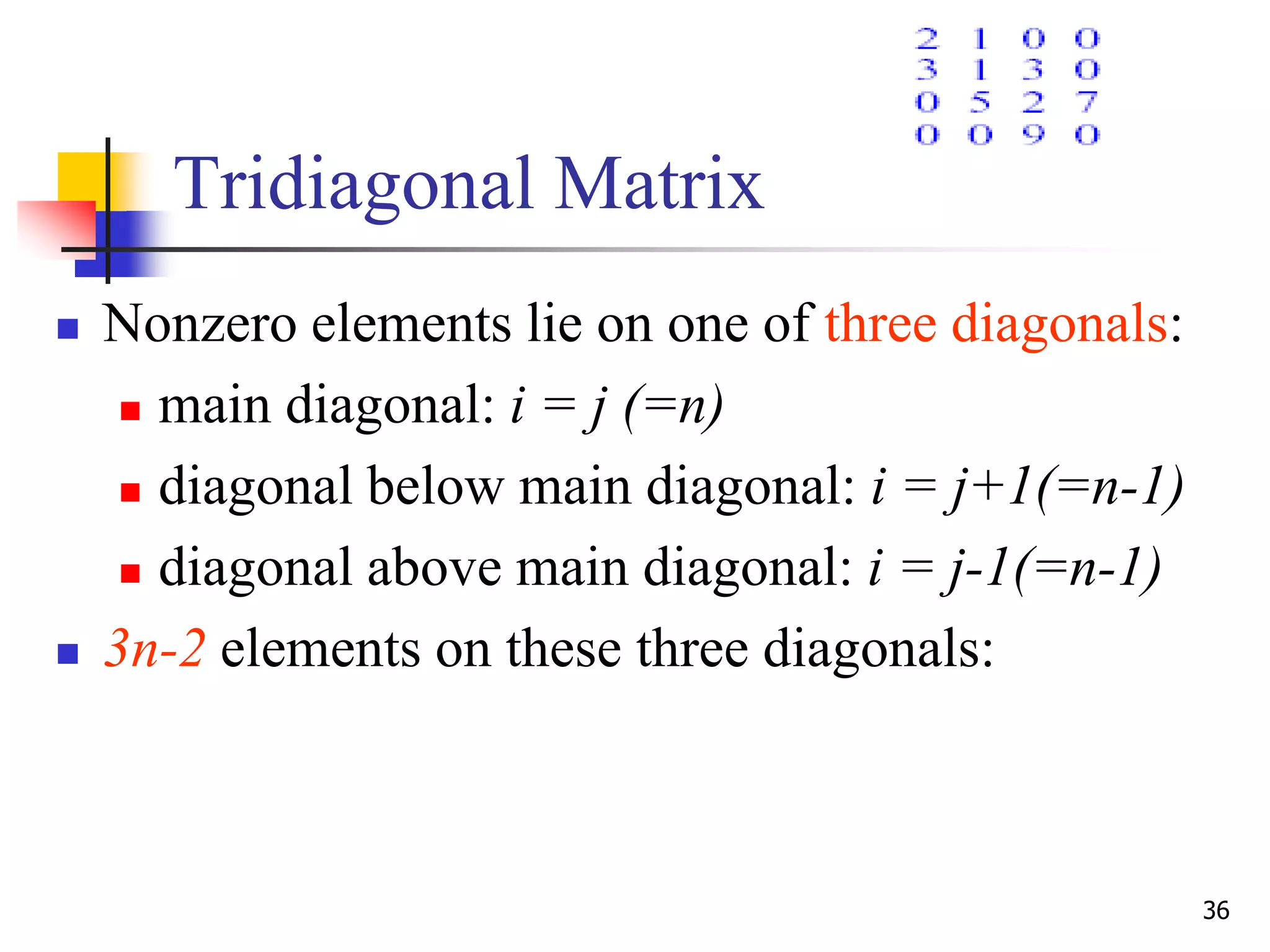

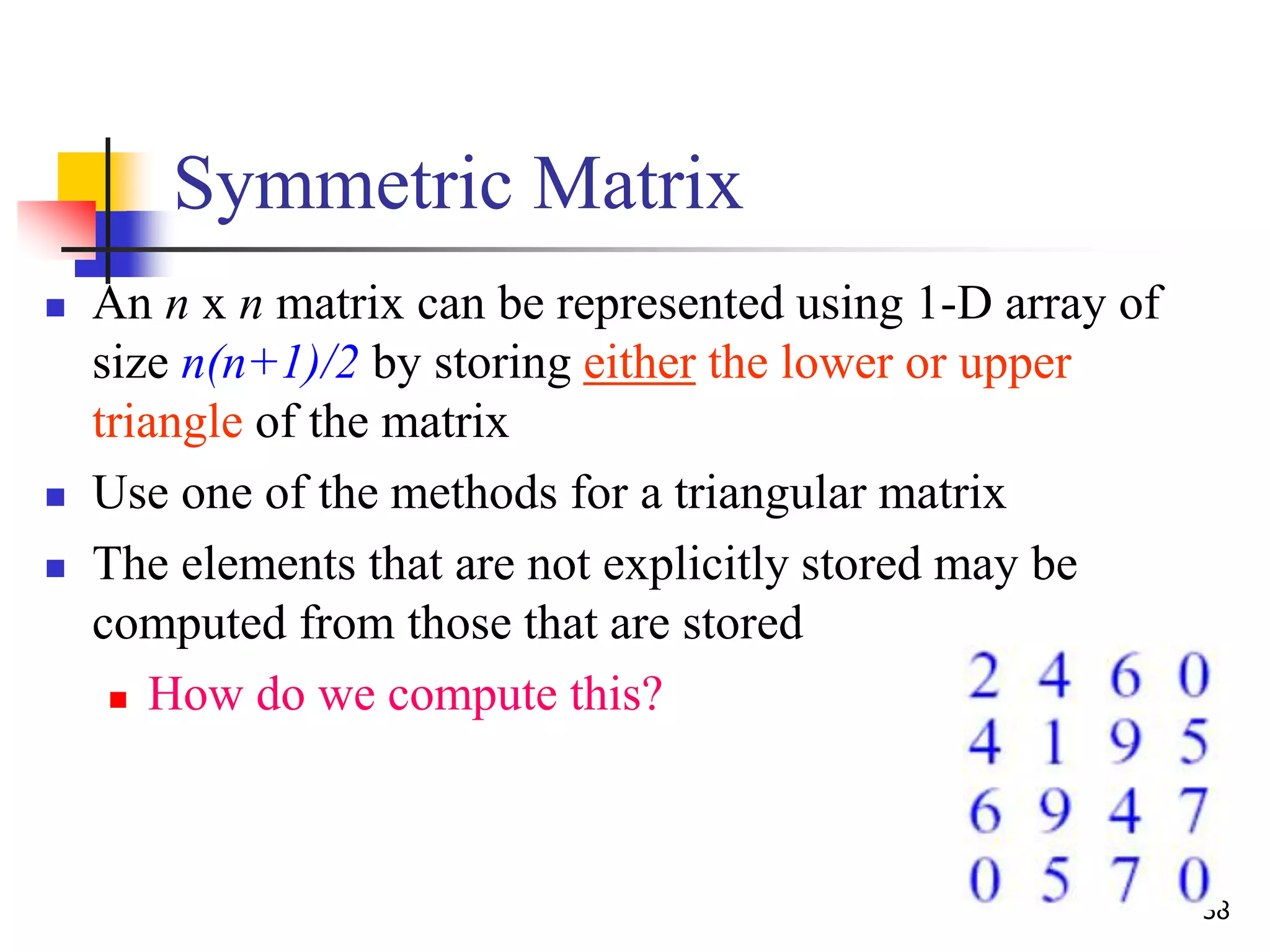





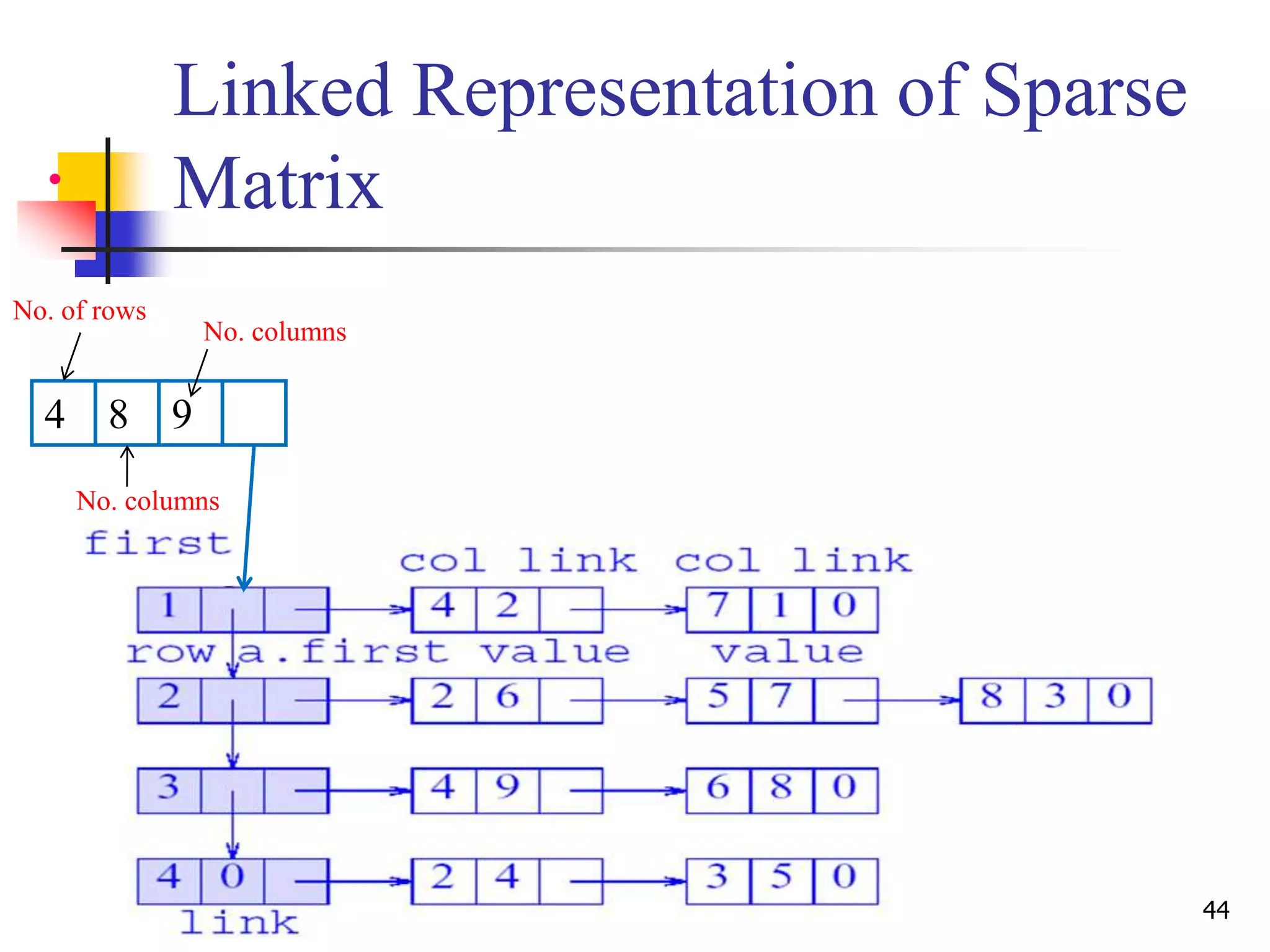

![Strings
Character type array is called string. All
strings end with the NULL character. Use
the %s placeholder in the printf() function
to display string values.
Declaration:
char name[50];
Dr. Hanif Durad 46
http://lectures-c.blogspot.com/2009/02/strings-in-c.html](https://image.slidesharecdn.com/chapter3ds-190904110927/75/Chapter-3-ds-46-2048.jpg)
![Example -1
#include
void main (void )
{
char *st1 = "abcd";
char st2[] = "efgh";
printf( "%sn", st1);
printf( "%sn", st2);
}
Dr. Hanif Durad 47
string1.c](https://image.slidesharecdn.com/chapter3ds-190904110927/75/Chapter-3-ds-47-2048.jpg)
![Example-2
void main(void){
char myname[] = { ‘H', ‘a', ‘n', ‘i', ‘f' };
printf("%s n",myname);
}
Dr. Hanif Durad 48
string2.c](https://image.slidesharecdn.com/chapter3ds-190904110927/75/Chapter-3-ds-48-2048.jpg)

![Example-3
#include <stdio.h>
# include <string.h>
void main ( )
{
char myname [40];
printf ("Type your Name :");
gets (myname);
printf ("Your name is :");
puts(myname);
}
Dr. Hanif Durad 50
string3.c](https://image.slidesharecdn.com/chapter3ds-190904110927/75/Chapter-3-ds-50-2048.jpg)
